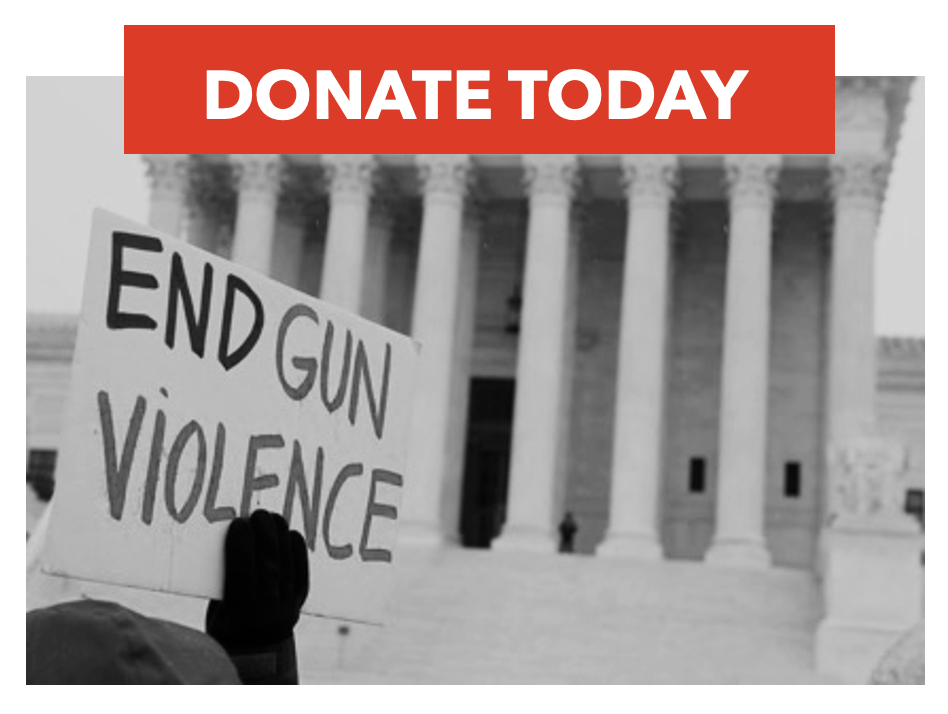If you’re serious about the worsening gun epidemic, then you should be serious about the FACTS.
This epidemic was triggered and is fueled by one of the most misguided blunders in Court history: the Heller decision.
The Heller Inflection
In 2008, the Supreme Court in District of Columbia v. Heller, for the first time in 200 years, found in the 2nd Amendment’s “keep and bear Arms” text an “implied” right to have and carry a handgun in the home for self-defense. Not addressing existing law—a state right to keep armed militia, under which there had been no gun epidemic—a divided 5-4 Court confidently declared: “We are aware of the problem of handgun violence in this country. . . . But the enshrinement of constitutional rights necessarily takes certain policy choices off the table.”
Since no one talks about what resulted, we’ve mapped the data to show how a dangerous new right to have a gun enabled a devastating gun epidemic.
 Heller isn’t solely responsible for the gun epidemic, but it is central to it. And central to Heller is guesswork invited by gun rights and control advocates. Neither side acknowledges Heller’s role, or deadly effects.
Heller isn’t solely responsible for the gun epidemic, but it is central to it. And central to Heller is guesswork invited by gun rights and control advocates. Neither side acknowledges Heller’s role, or deadly effects.
The correlation is undeniable. Justice Stevens later revealed, “all justices could foresee the negative consequences” of “such a radical change in the law,” calling Heller the “worst self inflicted wound in Court history.” In 2014, Stevens warned: it’s “profoundly important” to see Heller “curtails the power to regulate handguns that contribute to” the record gun violence, deploring “the slaughter caused by the prevalence of guns.”
It should then be no surprise that by 2015, America’s gun problem became a “Gun Epidemic,” declared by the New York Times.
More Guns, More Gun Violence
The numbers tell the story. Since Heller in 2008 (expanded by McDonald v. Chicago to all states in 2010), guns and gun deaths surged in tandem, from 305 to over 400 million guns and 31,500 to over 45,000 annual deaths.

Thanks to Heller, America suffers record gun proliferation and violence—twice daily mass shootings, daily school shootings, multiple daily suicides, domestic shootings, road-rage shootings, and accidents—that keeps growing worse, year after year.
To confront this epidemic, we need to understand the magnitude of Heller’s disastrous legacy. Let’s break it down.
Primary Effect: Feeding America’s Gun Obsession
Heller marks an unprecedented shift in the history of American gun ownership. Reinterpreting the 2nd Amendment from the longtime state right to maintain militia to an individual right to own guns, Heller made it unlawful and more difficult to regulate most gun ownership. The result has been a startling rise in gun proliferation.

The contrast is stark. Between 2008 and 2016 twice as many guns entered the U.S. market as did in the previous decade.
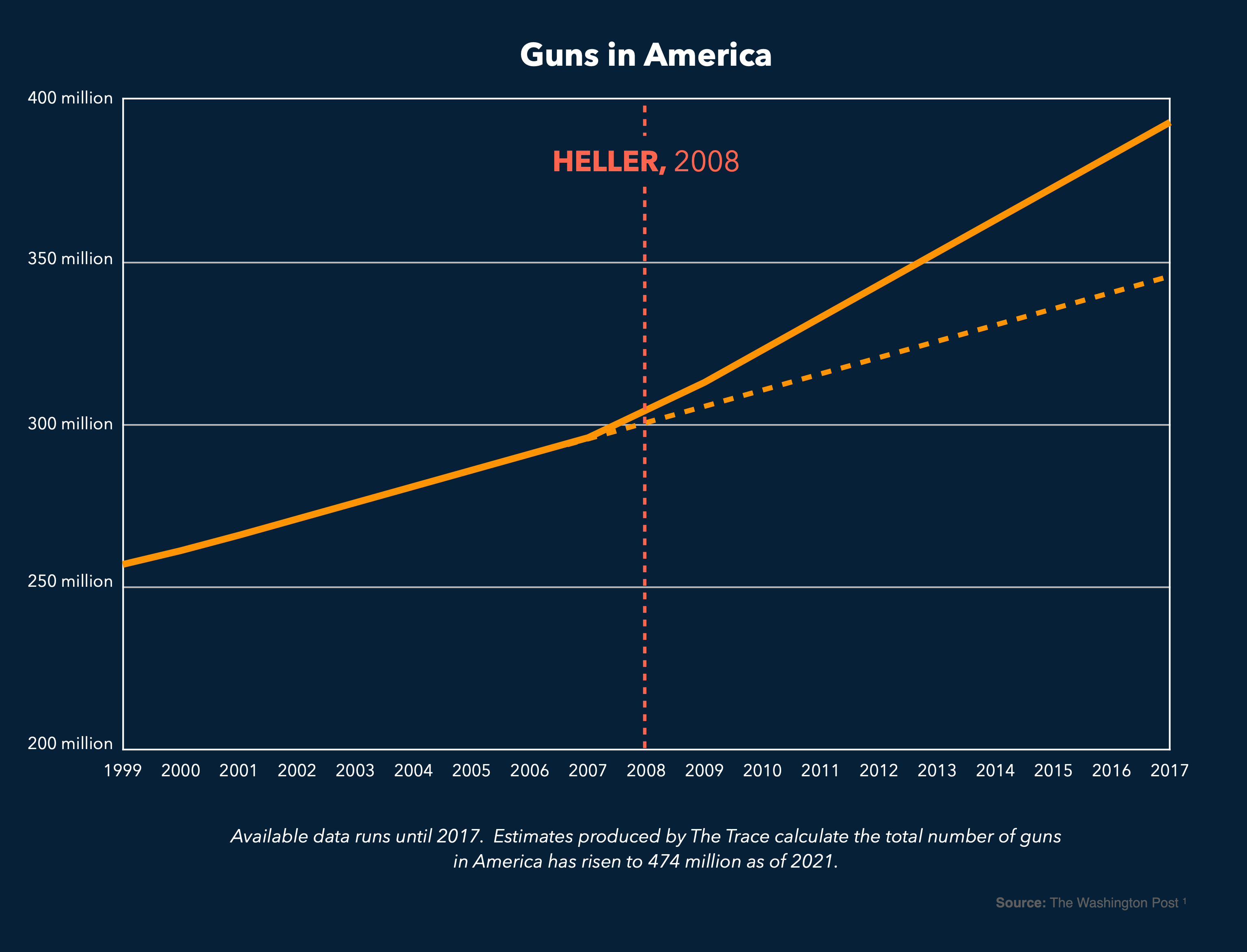
By 2017, this increase resulted in 393 million guns in private ownership, the equivalent of 6 guns for every 5 Americans.1 As of 2021, The Trace calculates the number of guns has risen to 474 million. In Heller’s America, it is now easier to buy guns than to regulate their safe use. The unsurprising result of this is a dangerous and sustained rise in gun violence.
Parallel Effect: a Gun Violence Epidemic
Heller’s boost to record gun ownership has been mirrored by record gun violence. Having undone and stifled legislative efforts at prevention, Heller enabled the sharpest rise in gun violence since the 1960s—a period of extraordinary civil unrest and assassinations during the Civil Rights Movement and Vietnam War—and reversed a historic drop in gun deaths.
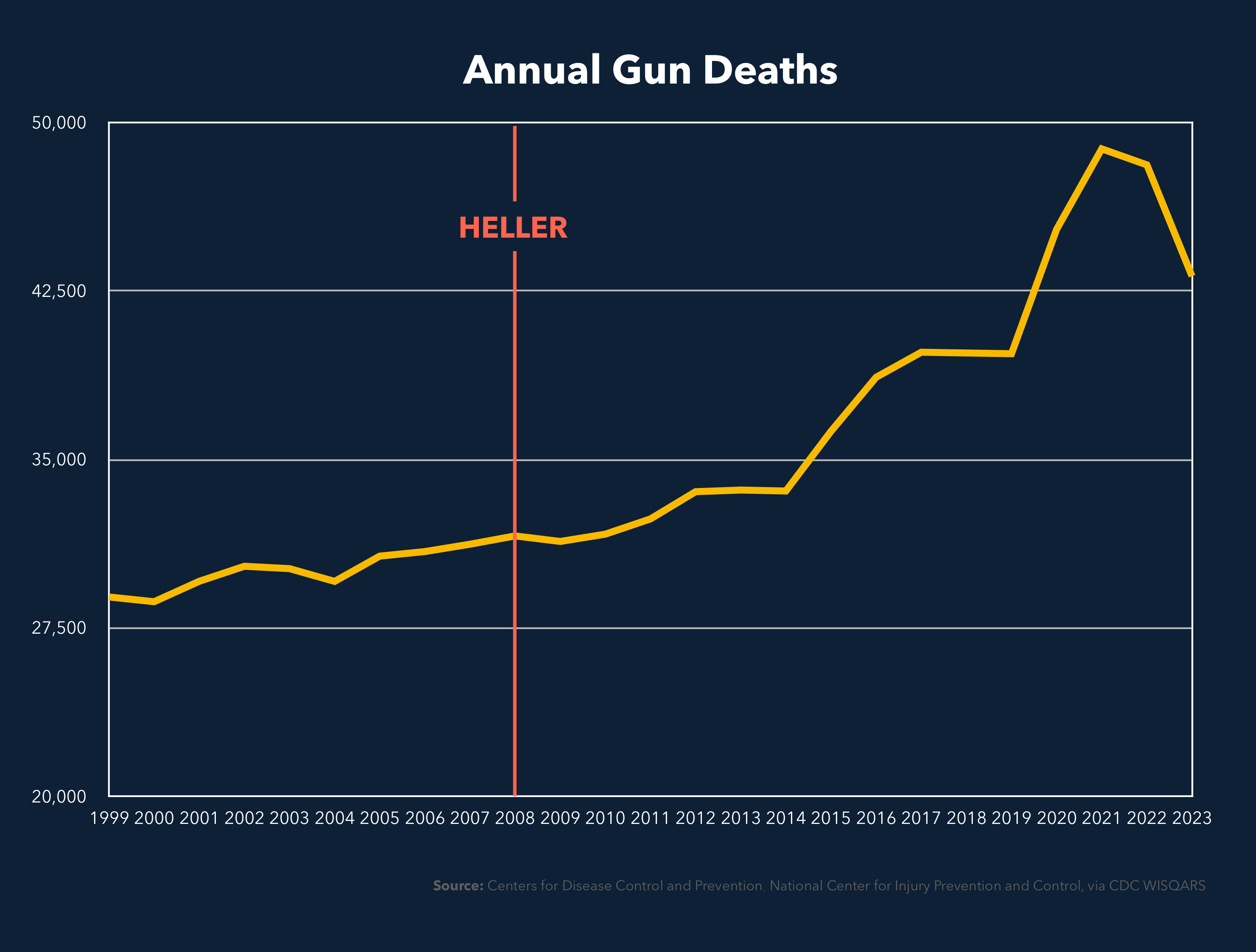
2017 had the highest number of gun deaths since records began in 1968, with 39,773 deaths documented. Since then, numbers have continued to rise. The Gun Violence Archive, a non-profit organization that tracks gun violence, has reported that annual deaths in 2020 far exceeded that previous record, reaching over 43,500.
Gun Suicides
Gun suicides have risen steadily over the fifteen years since Heller. 2018 set the record for both the highest rate and the highest number of gun suicides in 40 years.2

This rise is unsurprising in light of findings published in the New England Journal of Medicine that gun owners are four times more likely to commit suicide than non-gun owners. Multiple factors contribute, but guns are disproportionality dangerous, making up only 10% of all attempts yet over 50% of fatal attempts.3
It thus stands to reason that Heller’s new right, which has grown gun stock by almost 100 million in less than a decade, has contributed to a sharp rise in both overall suicides and gun suicides, showing how dangerous guns are for vulnerable individuals.
Yet Heller is commonly ignored by research. A 2020 study published in the Harvard Political Review cited 2006 as the start of the rise in gun suicides. But the decade ending 2008 showed a largely flat rate. Reflecting Heller’s impact, 2008 was the first year since 1998 the rate exceeded 6 per 100,000. Gun suicides took off after Heller and have increased ever since.
Mass And School Shootings
Heller also marks the beginning of a sharp rise in mass and school shootings.
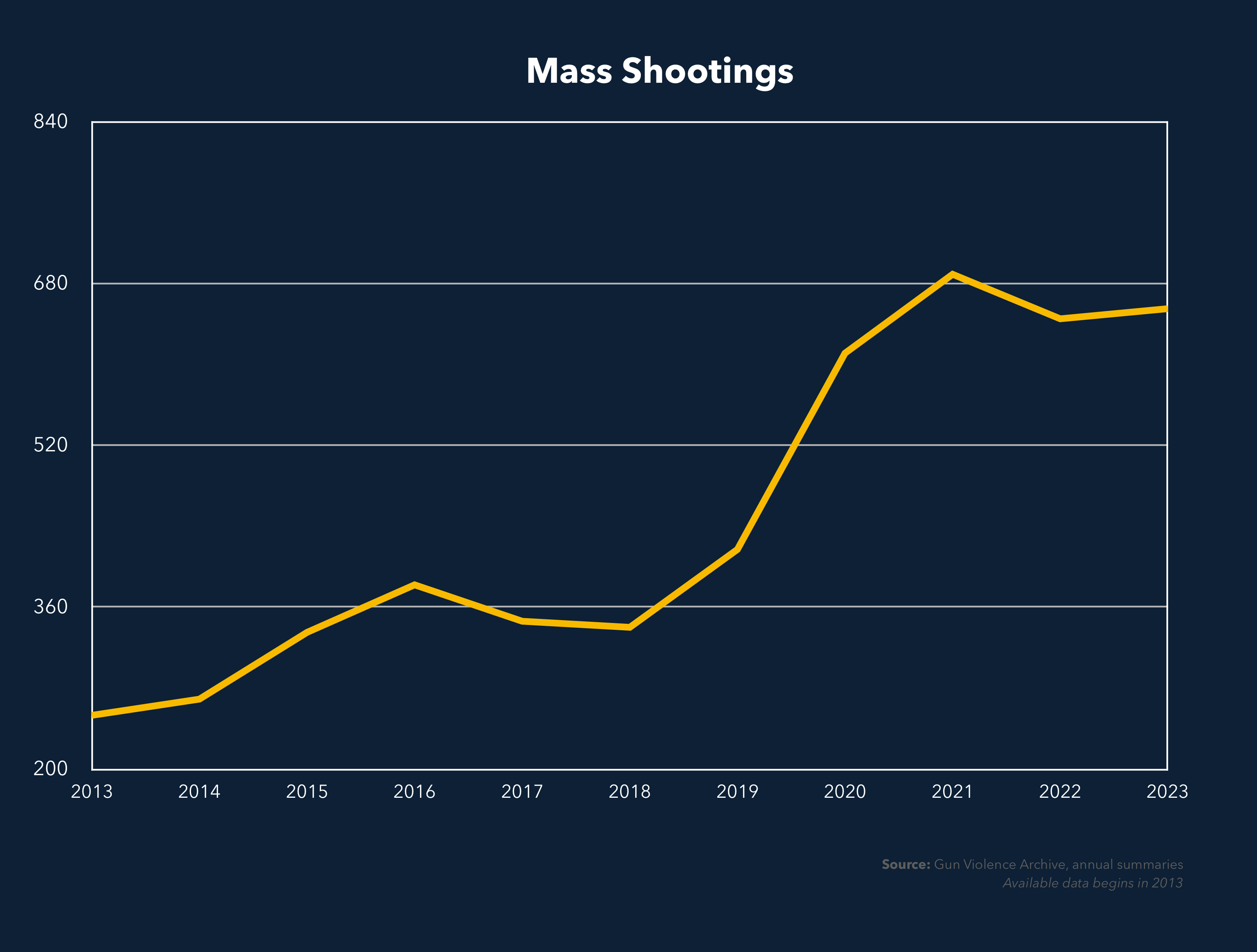
After records began in 2013, mass shootings steadily increased, becoming daily in the period 2015 through 2018, and jumping again since.
May 2020 marked the first month on record that mass shootings doubled to two a day according to the Gun Violence Archive. One month later, June 2020 broke this record with an average of three mass shootings a day, as did July, nearly matched again in August. That escalation made 2020 the first year in American history to exceed 600 mass shootings, which reached a new record of at least 688 mass shootings in 2021, that America is on pace to exceed in 2023.
None of this is normal. But it is the new normal in Heller’s America.
School shootings likewise have increased tenfold since Heller, according to data compiled by the k-12 School Shooting Database, whose surge after Heller was expanded nationwide by McDonald in 2010, could not be more graphic.
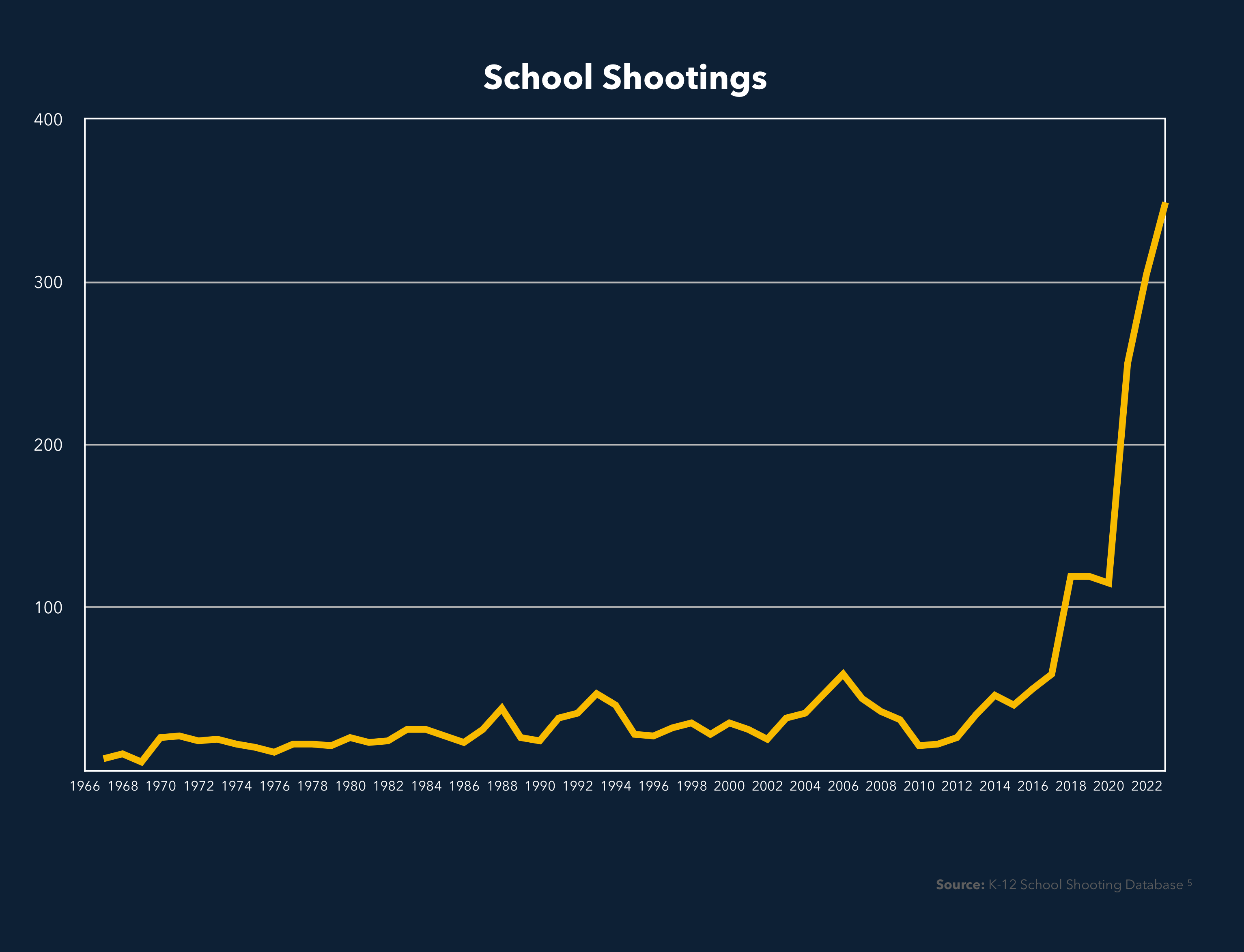
The available data shows a steady rise in both mass and school shootings post-Heller.
Desensitized to their increasing frequency, America fixates instead on the details and whether the incidents constitute mass shootings. Accurate analysis is difficult due to lack of a uniform definition and data. Gun Violence Archive requires 4 or more shot excluding the shooter, while Mass Shooting Tracker includes the shooter, yielding a higher count of 818 mass shootings last year. The oldest database is that of the FBI, but its definition, for “mass murder,” requiring 4 or more dead, greatly understates the problem. It excludes, for example, the 2020 cookout shooting in D.C. that left 21 shot and one dead—a mass shooting by any definition.
The limited data for mass shootings prior to 2013 and for school shootings prior to 2009 has obscured the Heller inflection. Regardless of data used, one thing is clear: the 15 years since Heller have seen a dramatic rise in mass and school shootings, so much so it triggered by 2018 a nationwide student March for Our Lives, and regular protests since.
Road Rage And Other Angry Shootings
Most fundamentally, by empowering all law-abiding citizens with guns, Heller turned those unable to control their human impulses while armed into “criminals.” This dynamic accounts for most gun violence today, whether mass shootings, school shootings, domestic shootings, or a new normal: road rage and other angry shootings.
“To understand the real problem of gun violence in the USA just google ‘Argument turns deadly.’ Angry people should not have a gun. Even normal people get angry.” (Andrew Wiles tweet, 7.24.22). After Heller, anger and other human emotions that were always part of human conflict were suddenly coupled with widespread accessibility of guns. The results were predictable, and predicted. As dissenting Justice Breyer warned, quoting the American Journal of Psychiatry: “‘Most murders are committed by previously law-abiding citizens, in situations where spontaneous violence is generated by anger, passion or intoxication.’” All three are presented in everyday shootings, the most visible perhaps involving road rage.
Before Heller, no one thought to track road rage incidents because they seldom led to shootings. But like mass shootings that were first systematically measured in 2014, shortly after Heller was expanded nationwide in 2010, road rage shootings had suddenly become another problem. Tracking revealed that road rage shootings doubled from 2014 to 2016, and again from 2017 to 2021 (Trace 5.2.22). They “continue to surge,” with one occurring now each day in America, in fact every 16 hours (Everytown 3.20.23).6
 These senseless road rage shootings are recorded in daily postings on Twitter/X by @DefensiveGunUse. They are now widespread and a real threat to all Americans on the roads. In September, even an Oklahoma judge succumbed to road rage, shooting six cars and twice rear-ending a woman who ‘cut him off.’
These senseless road rage shootings are recorded in daily postings on Twitter/X by @DefensiveGunUse. They are now widespread and a real threat to all Americans on the roads. In September, even an Oklahoma judge succumbed to road rage, shooting six cars and twice rear-ending a woman who ‘cut him off.’
Their details vary, but the petty, shocking nature of such shootings of other drivers, their passengers (often children) and bystanders is the same. And they are but part of the larger pattern of petty shootings in anger that now occur hourly across America.
Emboldened Pseudo Militia

Heller’s related right, of “citizens’ militia as a safeguard against tyranny” when order breaks down, has normalized intimidating, dangerous, and unlawful public displays of military-grade weapons by pseudo militia. It has inspired militia activity across America: in anti-government insurgencies including the U.S. Capitol, in statehouses and town halls, along the border, and at protests across the country, including those that turned deadly in Charlottesville, Kenosha and Portland.
Predictably, since Heller endorsed the myth of a citizen’s right to guns as a check on tyranny, there have been almost weekly “incidents of insurrectionist violence (or the promotion of such violence),” as catalogued by the Coalition to Stop Gun Violence on its “Insurrectionism Timeline.”
The Southern Poverty Law Center tracks private militias and radical anti-government groups, typically spouting “a set of baseless conspiracy theories about the federal government working to destroy the liberties of Americans.” Data compiled in its Intelligence Report shows the number of antigovernment ‘Patriot’ Groups—of which private militias are a part—has risen dramatically since Heller.
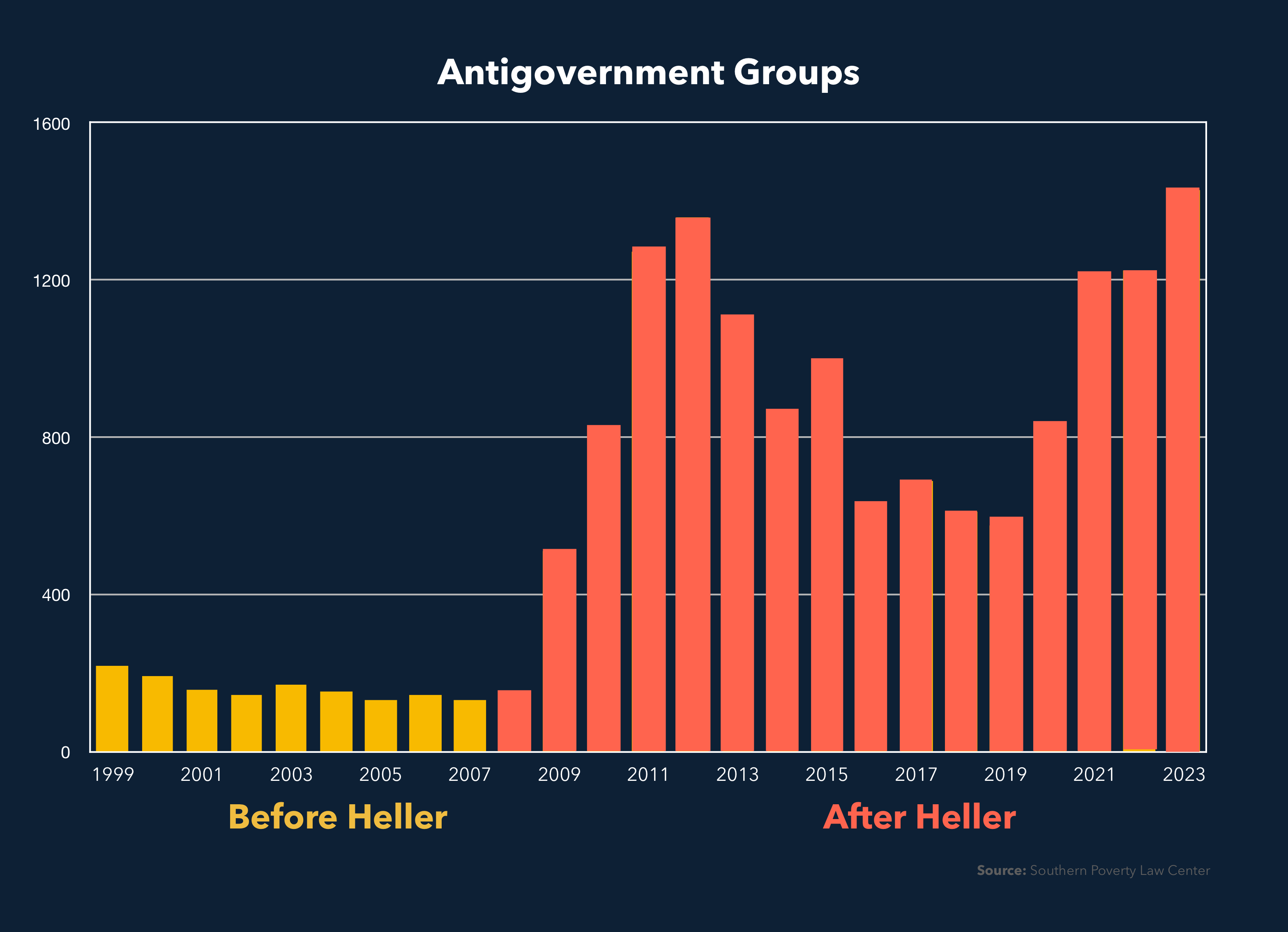
The overall number of these groups fluctuates, but the sustained elevation every year since Heller demonstrates they have become far more prevalent. Research into the relationship between these increases and Heller is limited, due again to the failure to consider the obvious correlation, and with it the clear threat Heller poses to domestic tranquility and public safety.
Misdirected Media, Research, and Solutions
Heller’s clear role has gone unnoticed, unresearched, and unaddressed for 15 years.
Mainstream media, never investigating or shining a spotlight on Heller’s role, have normalized unprecedented, increasingly-frequent shootings, which hardly make news anymore, reporting them, if at all, as an everyday “part of American life.”
Gun violence research, unfocused on Heller, misdirected, and lacking a centralized effort to comprehensively record the violence, has resulted in a fundamental misdiagnosis of the epidemic.
Gun violence prevention (GVP)’s institutional avoidance of the elephant in the room (and role in creating and perpetuating it) has left mainstream organizations to offer modest “common sense” reforms. They barely slow and won’t stop the rising epidemic.
Universal background checks won’t reach the ongoing misuse of 400 million guns, too often by angered, impassioned, or intoxicated law-abiding Americans. Age minimums, magazine limits, and red flag (“extreme risk”) laws won’t prevent most shootings. Most involve Heller-protected handguns that enable impulsive domestic violence and suicides in the home. When predictably taken out in public, as commonly done even before NYSRPA v. Bruen in 2022 extended Heller to public carry, they contribute to the unprecedented rise in impulse and grievance shootings, mass and school shootings, and street violence.
To Cure the Epidemic: Focus on and Overrule Heller
The divisive debate over America’s gun epidemic targets its symptoms—typically the circumstances of each shooting, shooter, gun, and purchase. It ignores the disease.
The country struggles to make sense of WHY THIS KEEPS HAPPENING and get past the empty ritual of thoughts and prayers. Few ask—not media, researchers, other GVP groups—what’s behind the growing gun violence, and what to do about it.
They remain focused on modest solutions; not the deadly, chilling effects of Heller which triggered this crisis, and blocks and marginalizes legislative efforts to end it.
Justice Stevens, recognizing the root of the problem, urged “more effective and more lasting reform.” As implored in his memoir, “overruling Heller is desperately needed to prevent [more] tragedies.”
AEP, dedicated to overturning Heller in the courts, takes no position on what legislative reform might be, whether at the state and local level under each State’s constitution, or in Congress. But when real reform becomes possible post-Heller, examples of what is possible abound.
Canada next door, that shares not only a long border but our heritage, frontier experience, and rural-urban divide, classifies firearms as non-restricted (hunting rifles), restricted (handguns and semiautomatics) and prohibited (certain handguns and automatic weapons). That seems to work for gun rights and control groups alike. And for schools: against our 34 school shootings as of the March 24, 2018, March for Our Lives,4 the number in Canada: zero.
Or Australia, which experiences few mass shootings since gun reforms in 1996. “Few Australians would deny their country is safer today,” says its former prime minister.
Or Great Britain, the direct descendent of “our English forefathers” in whom Heller found a supposed “ancient right of individuals to keep and bear arms.” Today, Britain has some of the strictest gun laws and lowest gun violence in the world, and its media assail America’s “obscene proliferation of guns.”
To learn more, visit Gun Crisis, About AEP, 2nd Amendment Explained, and Heller’s 2nd Amendment.
Know the truth about Heller, and help us end its epidemic.
We are a non-profit 501(c)(3) organization.
Gifts to the American Enlightenment Project are tax-deductible.
1 – The Washington Post https://www.washingtonpost.com/news/wonk/wp/2018/06/19/there-are-more-guns-than-people-in-the-united-states-according-to-a-new-study-of-global-firearm-ownership/
2 – John Hopkins: Bloomberg School of Public Health https://americanhealth.jhu.edu/article/how-do-gun-laws-affect-suicide-rates
3 – Gifford Law Centre https://lawcenter.giffords.org/facts/gun-violence-statistics/
4 – P. Krishnakumar,“Since Sandy Hook, a gun has been fired on school grounds nearly once a week,”Los Angeles Times (updated through Mar. 22, 2018). https://www.latimes.com/projects/la-na-school-shootings-since-newtown/
5 – K-12 School Shooting Database, “All Shootings at Schools From 1966-Present.” https://k12ssdb.org/all-shootings
6 – Everytown for Gun Safety, “Road Rage Shootings Are Continuing to Surge” (3.20.23) https://everytownresearch.org/reports-of-road-rage-shootings-are-on-the-rise/?

